“So that by that time the Grimm brothers arrived to began their collection, much material had overlain the remote mythology of the early tribes. Tales from thee four quarters, inventions from every level of society and all stages of Western history were commingled. Nevertheless, as they observed, a homogeneity of style and character pervades the total inheritance. A continuous process of re-creation, a kind of spiritual metabolism, has so broken the original structures in assimilating them to the living civilization, that only the most meticulous and skillful observation, analysis and comparative research can discover their provenience and earlier state. The Grimm brothers regarded this rich composition as a living unity and sought to probe its past …”
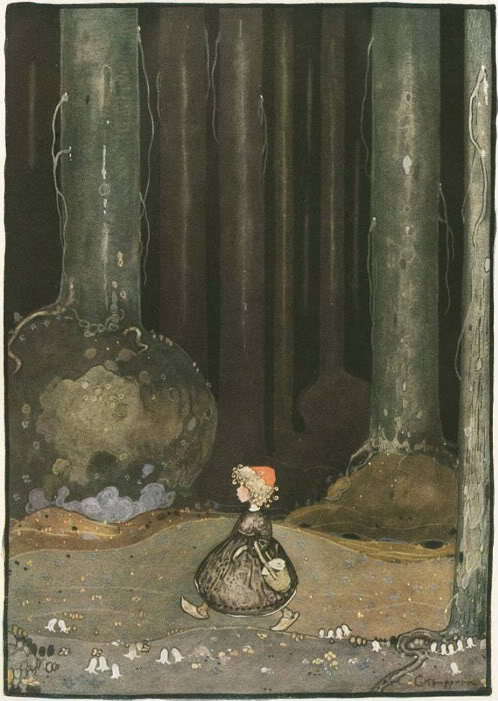
Kim Capenter:In this regard, Zipes underscores the redemptive lesson inherent in so many of the narratives: the trod upon socially inferior outsider gains his right- ful place in society, because he is more clever and wiser than monarchs and aristocrats. While riches often fall to such heroes, wealth and treasure are al- ways secondary, even tertiary, prizes. The primary reward is to become a good, upstanding, contribut- ing member of society. Along with this social mobil- ity come acceptance and a comfortable standard of living. Zipes expands upon this observation by ex- ploring the similarities between Odysseus and Tom Thumb, the former serving as the prototype of the ultimate bourgeois hero. Trials and tribulations be- fall the Grimms' male protagonists, but it is self- abnegation and self-discipline, traits not widely asso- ciated with the aristocracy, that ultimately result in reward. Through self-denial, the fairy tale heroes out- wit their betters, thereby gaining self-determination over their own lives. While today such a narrative seems formulaic...
The year 1812 brought Napoleon’s retreat from Moscow and, like a quiet fanfare of German rejoicing, the first volume of the “Nursery and Household Tales” . But the iron Jacob Grimm had to use his iron in more than scholarship. In 1814, after Jerome Bonaparte’s expulsion, Jacob was sent to Paris to demand resitution of his village library, Kassel, which the French had stolen. Later that year he was secretary of the Hessian legation at the Congress of Vienna, presenting- among the uniforms and ball gowns- the sharp, tough image of an uncompromising intellectual, learned in law, history, national rights.
And then he was off to Paris again, demanding the return of more filched books. The French librarians feared and hated him: “Nous ne devons plus souffrir ce Monsieur Grimm.” The other Monsieur Grimm- gentle, unassertive, stayed at home, wandering through the villages around Kassel and listening quietly to folk tales. Nobody ever said that he was insufferable.
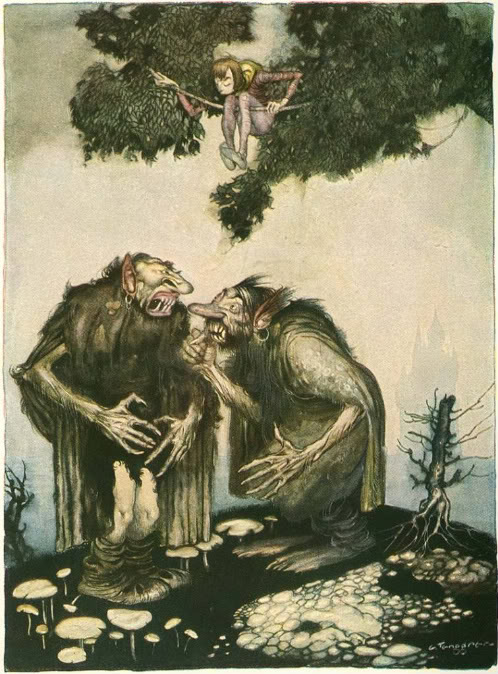
Gustaf Tenggren. 1923. Campbell:This was the first major flourishing in Europe of a literature of the people. From right and left the materials came, to the left and right they were flung forth again, sealed with the sign of the late Gothic; so that no matter what the origin, they were now the re-creation of the European folk. Much of this matter found its way into the literary works of the late Middle Ages, thee Reformation and Renaissance (Boccaccio, Chaucer, Hans Sachs, Les cent nouvelles nouvelles, etc.) and then back, reshaped, to the people. The period of abundance continued to the time of the Thirty Years' War (1618-1648). Finally, in France, at the court of Louis XIV, a vogue commenced for the delicate refashioning of fairy tales and fables--inspired, in part by a new French translation of a late Persian rendering of the Arabian Panchatantra, part by Antoine Galland's rendition of the Arabian Thousand Nights and One Night. The pastime yielded a plentiful harvest of freshly wrought, delicate pieces (La Fontaine, Perrault, the forty-one volumes of the Cabinet des Fees). Many were taken over by the people and crossed the Rhine.
Much of the rest of their story is of academic appointments, hard work, the slow amassing of honors, culminating in an exalted professorship and the final dignity of the Academy of Sciences in Berlin. There they stayed, accumulating honors and reputation till they died. Wilhelm succumbed to heart failure in 1859; Jacob followed four years later. In Berlin they lie buried side by side.Snow White and Rose red had had a good life: “they divided between them the great treasure which the dwarf had gathered together in his cave.” The rose trees that were their totems stand before the window,” and every year bear the most beautiful roses, white and red.”
There are no roses without thorns, and Jacob’s tree is thornier than Wilhelm’s. Jacob pricks us more sharply with the grim science of philology. Most people respond with smiles to Grimm’s fairy tales but with shudders to Grimm’s law. And yet one achievement is relevant to the other. To probe into the dark forest of German folklore meant also to examine the trees, root and branch, leaf and bark: no lore without language. Jacob was the first grammarian of German to look at the language as a process working through time, not as a static museum filled with fixed an immutable words. He started his “Deutsche Grammatik” in 1819 and finished it in 1822, the year of Grimm’s law.
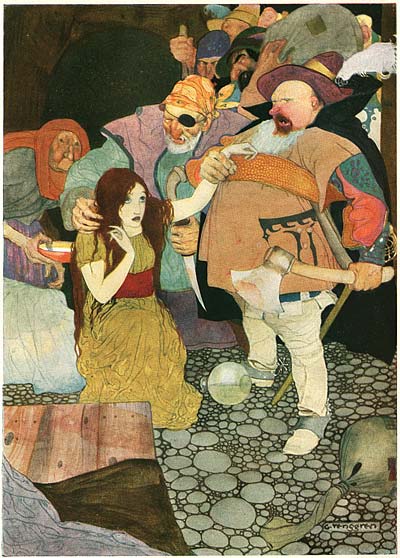
Tenggren. Illus. 1923. Donal Haase: a groundbreaking work of fairy-tale scholarship that introduced the sociohistorical study of fairy tales to English-speaking scholars is being republished in a revised and expanded edition. That work is Jack Zipes's Breaking the Magic Spell: Radical Theories of Folk and Fairy Tales. First published in 1979, Breaking the Magic Spell challenged readers to evaluate the "magic" of fairy tales critically, "to grasp the socio-historical forces" (xi) that shaped the tales, and thereby not only to understand their utopian roots and emancipatory potential, but also to lay bare the false magic and deceptive allure of tales created by the culture industry. Breaking the Magic Spell was in every respect a social and political project, one influenced, as Zipes himself points out, by "the influence of the student and anti-war movement of the late 1960s and 1970s, the resurgence of interest in Marxism, ...
What is Grimm’s law all about? It is about language as a changing, living thing, and it is about the patterns of linguistic change. To Jacob Grimm, as to the other language scholars of his time, the term “German” did not mean just the tongue spoken in Berlin or Gottingen or Kassel. It meant everything that could be recognized as a dialect of German, and it moved to the borders of languages that were not German at all-English , Dutch , Danish, Swedish. English, after all, is a kind of German:”My father is a good man” is demonstrably of the same family as “Mein Vater ist ein guter Mann.”
It seemed that there had once been a parent language, now long dead, that had had many children-some of these themselves dead- the tongues of the Goths and Vandals among them- ; others, like English and Dutch and High German- were much alive. You could see that all these teutonic languages were brothers and cousins; they all ate “Butter” and drank beer or “Bier”. They had diverged somewhat from each other, and words that must have had a common origin had grown apart. Thus, German used the word “Zahn” and English preferred “tooth.”
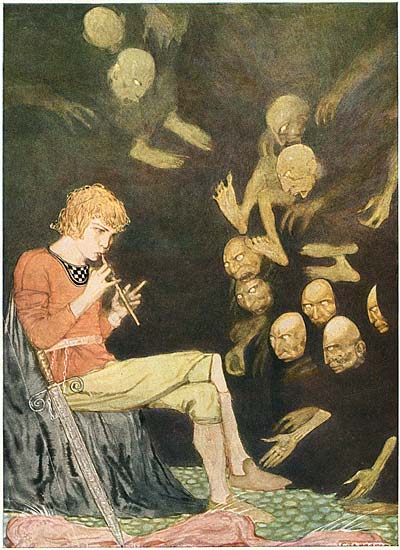
Jack Zipes:Recent research such as Heinz Rölleke’s Die älteste Märchensammlung der Brüder Grimm, 1975, has demonstrated that the Grimms made enormous changes in recording oral and literary European tales to suit their political and literary interests. Nor did they eliminate all the Perrault tales in the second edition as Darnton argues. In fact, by the seventh edition, many Perrault and French tales were added. In effect, the Grimms created a national “institution” in collection and stylizing folk and fairy tales since they endowed them with characteristics and qualities which, they hoped, would foster German identity and unity. However, by no means were
original tales in their collection already stamped by a specific “German” character.But if you compared ancient enough writings in both languages, you would find that the German Z ( pronounced “ts” ) was once “t”, just as in English, and that there had even been a “th” after what was now the final “n”; the German word had been “tahnth”. And once upon a time English had had the word “tanth.” In England this word had changed by a quite natural process to “tooth”; first of all get rid of the “n” and, as compensation, nasalize the preceding “a” ; then get rid of the nasalization ; then change the “a” to a good long “o”, giving “toth”; then push the back of the tongue higher, giving the “tooth” we have today. By examining the history of sound changes in reverse, you end up with German and English as pretty much the same language.
There was a time, then, in prehistory, when the children-English, Dutch, Norwegian, and so on- had not been born: only the original parent existed. This parent had left no written records; you could only discover roughly what he had been like by comparing his children one with the other. The earliest language of the Teutonic family that had left any records was Gothic, the tongue of the barbaric invaders of Rome, but it gave some idea of the character of the great dead Germanic father; the grammar was complicated, and there were endings somewhat like Latin. Jacob Grimm’s language book caught a shadowy, conjectural image of the “Urvater” , the original primitive Germanic tongue. And it asked the question how did this tongue come into existence?
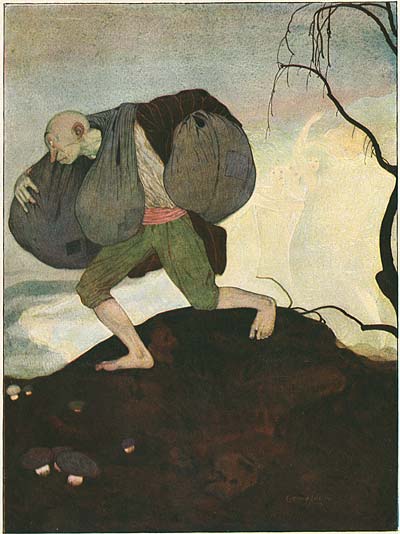
The Grimm Brothers, Max Müller, Andrew Lang, and others, have pointed out that folk tales are "monstrous, irrational and unnatural," both as to the elements of which they are composed, and as to the plots that unify these elements. Since a tale may have a different origin from its elements, two questions propose themselves: What is the origin and meaning of the motifs? What is the origin and meaning of the tales?---They must be explained as myth is explained. But then, how is myth explained?
ADDENDUM:
Nin Harris: “…the mystique and force behind the literary fairy tale. This hinges on the elements of magic and the uncanny. Zipes quotes and modifies Freud in order to show how it is this element of the uncanny is one of the “significant elements” of the fairy tale, which survives modification again and again in order to weave its way into the consciousness of either child or adult. This is the crux of Zipes’ argument , that “the very act of reading a fairy tale is an uncanny experience in that it separates the reader from the restrictions of reality from the onset and makes the repressed unfamiliar familiar once again” .
Zipes equates this with a quest for home, which is psychological and nebulous in the first instance (within the reader’s mind) and which is social and value based in the second(within the tale). He goes on to delineate the potential for liberation within the world of the fairy tale. Zipes asserts that it is a process of moving from a child’s inner world to the outer world via a process of identification and objectification of the canny within the uncanny (that is: all that is not familiar) thus acclimatizing the child to his role in life. This can be done in a regressive way, via the tales of Perrault and his contemporaries, or in a manner that reflects the “process of struggle against all times of suppression and authoritarianism”. Zipes is of course espousing the latter.”
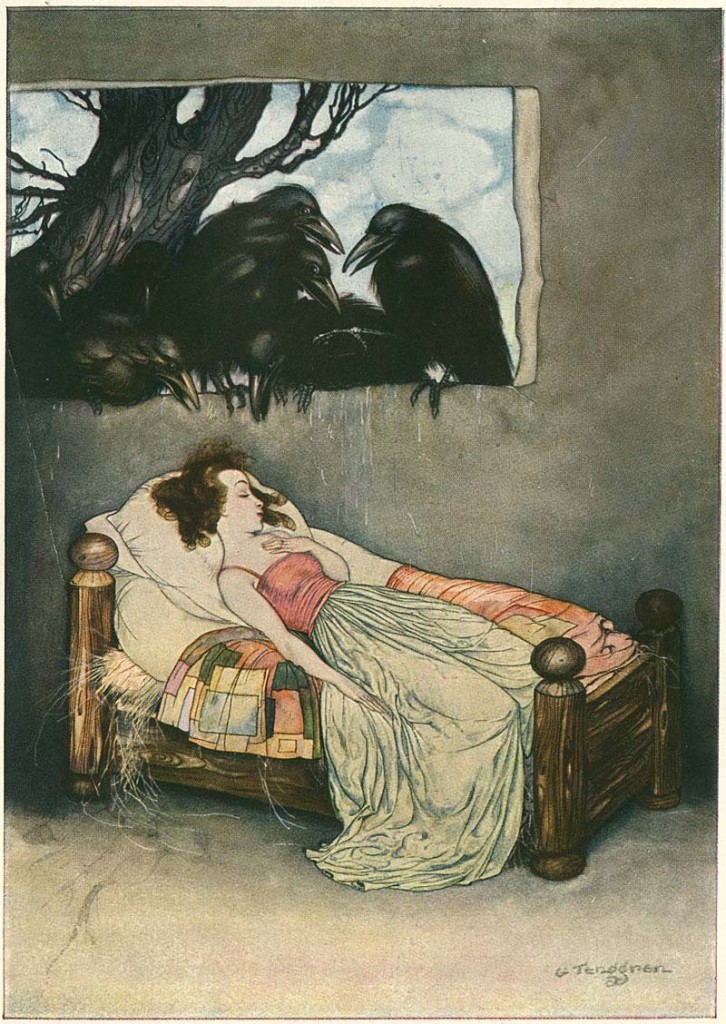
Walter Benjamin:The fairy-tales is the earliest step man has taken to free himself from the pressure of the mythical. The liberating magic which the fairy tale has at its disposal does not bring nature into play in a mythical way, but points to its complicity with liberated man. A mature man feels this complicity only occasionally, that is, when he is happy; but the child first meets it in fairy tales, and it makes him happy
Joseph Campbell: A fourth viewpoint was propounded by the French sociologist, Emile Durkheim. He argued that the collective superexcitation (surexcitation) of clan, tribal, and intertribal gatherings was experienced by every participating member of the group pas an impersonal, infectious power (mana); and this power would be thought to emanate from the clan or tribal emblem (totem); and this emblem, therefore, would be set apart from all other objects as filled with mana (sacred vs. profane). This totem, this first cult object, would then infect with mana all associated objects, and through this contagion there would come into being a system of beliefs and practices relative to sacred things, uniting in a single moral community all believers.
The great contribution of Durkheim’s theory, and what set it apart from all that had gone before, was that it represented religion not as a morbid exaggeration, false hypothesis, or unenlightened fear, but as a truth emotionally experienced, the truth of the relationship of the individual to the group.
This recognition by Durkheim of a kind of truth at the root of the image-world of myth is supported, expanded, and deepened, by the demonstration of the psychoanalysts that dreams are precipitations of unconscious desires, ideals, and fears, and furthermore, that the images of dreams resemble–broadly, but then frequently to the detail–the motifs of folk talk and myth. Having selected for their study the symbol-inventing, myth-motif-producing level of the psyche–source of all those universal themes (“Elementary Ideas”) which men have read into the phenomena of nature, into the shadows of the tomb, the lives of the heroes, and the emblems of society–, the psychoanalysts have undoubtedly touched the central moment of the multifarious problem.
In the light of their discussion, theories which before seemed mutually contradictory become easily coordinated. Man, nature, death, society–these have served simply as fields into which dream-meanings have been projected. Hence the references of the wild motifs are not really (no matter what the rationalizing consciousness may believe) to the sun, the moon, the stars–the wind and thunder–the grave–the hero–or even the power of the group, but through these, back again to a state of the psyche. Mythology is psychology, misread as cosmology, history, and biography.





 COMMENTS
COMMENTS